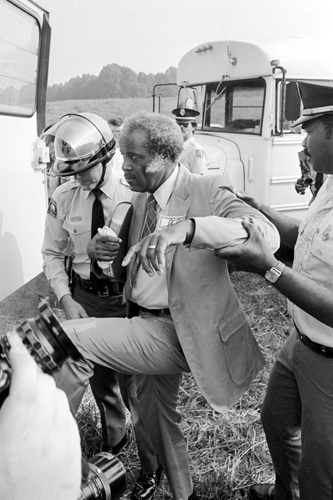A Movement Is Born: Environmental Justice and the UCC

Marking the 35th Anniversary of the Warren County Civil Disobedience Campaign and the 30th Anniversary of the Toxic Wastes and Race Report
Through the leadership of Dollie Burwell, the Rev. Leon White, the Rev. Benjamin Chavis, Jr., and the UCC’s Commission for Racial Justice, the United Church of Christ served as the leading organizational force in the birth of the environmental justice movement. The story of how this movement arose begins in the late 1970s when a group of residents formed the Warren County Citizens Concerned (WCCC) and began to protest the state of North Carolina’s designation of a landfill in their county for the disposal of polychlorinated biphenyls (PCBs), a toxic chemical substance whose production was banned by congress in 1979. With a population that was roughly 62% black, no other county in the state had a higher percentage of black residents, and only a few of the state’s one hundred counties could claim higher poverty rates. The placement of the landfill became to be regarded as an instance “environmental racism,” a phrase coined by Chavis

While Chavis would ultimately take the helm of the UCC’s Commission for Racial Justice, it was White who served as the commission’s Executive Director when the WCCC first involved the group in its efforts. Both White and Chavis ultimately played leading roles in what became the watershed event in the launching of the movement. In September of 1982, the first trucks carrying PCB contaminated soil drove into Warren County but were met by hundreds of protestors who laid down on the highway to prevent their arrival. On the first day of action, 55 protestors were arrested. The protests lasted six weeks and were covered by the national media. By the end, 523 arrests were made.
The attention garnered by the demonstrations in Warren County laid the foundation for more activism and consciousness-raising. In an article that appeared in the New Yorker, Chavis later recalled, “Warren County made headlines. And because it made headlines in the media, we began to get calls from other communities. But you know that in the eighties you couldn’t just say there was discrimination. You had to prove it.”
Under the leadership of Chavis, the UCC’s Commission for Racial Justice issued its landmark 1987 report Toxic Wastes and Race in the United States. The study found that race rose to the top among variables associated with the location of a toxic waste facility. Three out of five Black and Hispanic Americans lived in a community that housed what the EPA called an “uncontrolled toxic waste site,” a closed or abandoned site that posed a threat to human health and the environment.

A documentary called “Earthkeeping: Toxic Racism” notes that the findings of the report generated “a big national debate” on the racial demographics of communities that hosted toxic waste facilities. In an interview for the film, Chavis noted, “The issue of environmental racism is an issue of life and death. It is just not an issue of some form of prejudice where someone doesn’t like you because of the color of your skin. This is an issue that will take your life away, if you don’t get involved.”
In 1991, Chavis and the UCC’s Commission for Racial Justice would again play a leadership role in a formative event for the environmental justice movement by organizing the First National People of Color Environmental Leadership Summit in Washington, DC. At this conference, more than 600 persons gathered and ultimately adopted seventeen Principles of Environmental Justice. The proceedings of the summit note that this historic document immediately impacted a United Nations Conference on Environment and Development, and the principles were soon reprinted in over a thousand publications.

In 2007, Justice and Witness Ministries of the United Church of Christ continued the work of the Commission for Racial Justice by publishing Toxic Wastes and Race at Twenty: 1987-2007. This report found that racial disparities in the location of toxic waste facilities were “greater than previously reported.” People of color comprised the majority of the population in communities within 1.8 miles of a facility.
Today, the United Church of Christ continues the work of movement building through a variety of programs that seek to activate and equip congregations across the country for environmental justice ministries that have become a core part of the denomination’s DNA.
